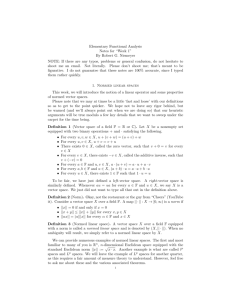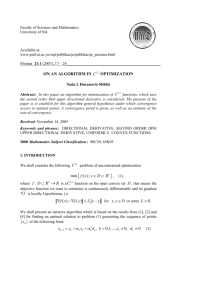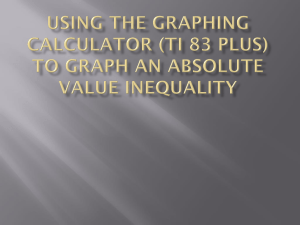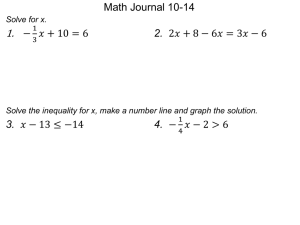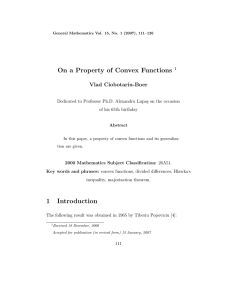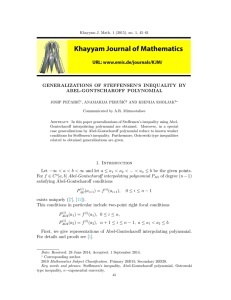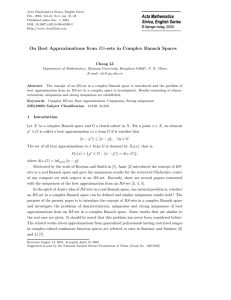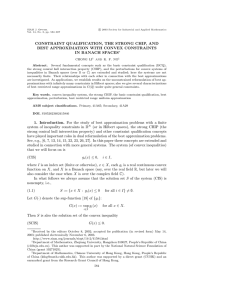L1 MA5241
advertisement
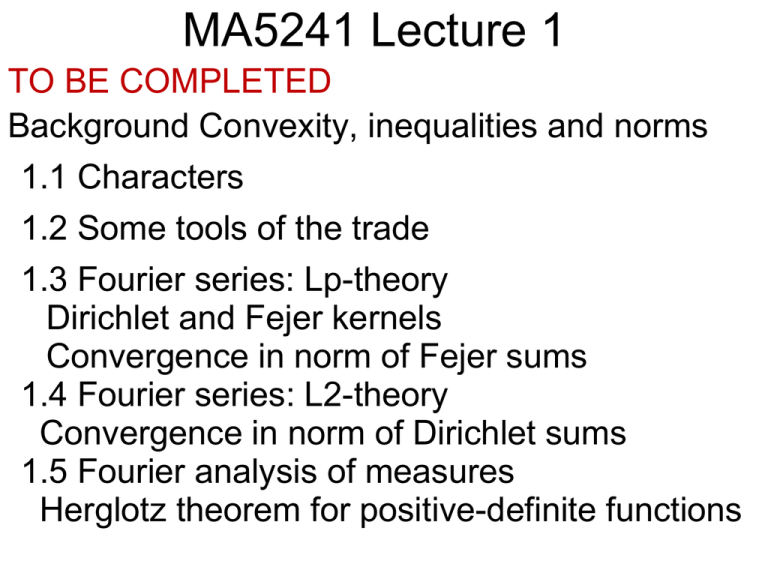
MA5241 Lecture 1
TO BE COMPLETED
Background Convexity, inequalities and norms
1.1 Characters
1.2 Some tools of the trade
1.3 Fourier series: Lp-theory
Dirichlet and Fejer kernels
Convergence in norm of Fejer sums
1.4 Fourier series: L2-theory
Convergence in norm of Dirichlet sums
1.5 Fourier analysis of measures
Herglotz theorem for positive-definite functions
Convexity
Definition A subset K of a real vector space V is
convex if
p , q K , t [ 0 ,1], (1 t ) p tq K
Definition A function f : [a,b] R is convex if the cord
connecting any two points on its graph lies on or above
the graph
a
b
Convexity
Question Show that if f is convex then f is continuous
Question Show that
f C ([ a , b ]), f nondecreas ing f convex
1
Question Show that
f C ([ a , b ]), f 0 f convex
2
Question Show that if f is convex then
p , q [ a , b ], t [ 0 ,1]
f (( 1 t ) p tq ) (1 t ) f ( p ) tf ( q )
Jensen’s Inequality
Question Derive Jensen’s Inequality for convex f
p1 ,..., p n [ a , b ], c1 ,..., c n [ 0 ,1]
f
n
i 1
n
i 1
ci 1
ci pi
n
i 1
ci f ( pi )
Suggestion Use the answer to the previous result in
combination with an induction argument
http://en.wikipedia.org/wiki/Jensen's_inequality
Arithmetic-Geometric Inequality
Question Show that for
p1 ,..., p n 0
the Geometric Mean G ( p1 ,..., p n ) ( p1 p n ) 1 / n
and Arithmetic Mean A ( p1 ,..., p n )
1
n
( p1 p n )
satisfy G ( p ,..., p ) A ( p ,..., p )
1
n
1
n
Suggestion Consider the function
f ( x ) log( x ), x 0
Harmonic-Geometric Inequality
Question Show that for
p1 ,..., p n 0
the Harmonic Mean
H ( p1 ,..., p n )
n
1
p1
1
pn
satisfies
H ( p1 ,..., p n ) G ( p1 ,..., p n )
Young’s Inequality About Products
If
p, q 0
then for all
1
satisfy
p
a, b 0
a e
x/ p
1
q
ab
,b e
1
a
p
b
p
y/q
,t
q
1
p
.
ab f ( t x (1 t ) y ) t f ( x ) (1 t ) f ( y )
a
Proof Set
Since
f ( x) e
x
q
is convex
p
p
b
q
q
Legendre Transform
Definition Let
Definition The Legendre transform of a convex function
f ( y ) max ( yx f ( x )),
x [ a , b ]
y [ f ( a ), f ( b )]
'
'
http://en.wikipedia.org/wiki/Legendre_transform
Question Show that
xy f ( x ) f ( y ),
x [ a , b ], y [ f ( a ), f ( b )]
p
q
x
y
f ( y)
Question Show that f ( x )
p
q
and use this to derive Young’s Inequality
'
'
Function Spaces
Definition For ( , d ) a measure space and p [1, ]
define L p ( , d ) { f : C measurable
such that
| f | d } For
p
f L ( , d )
p
let || f || p denote the p-th root of this integral.
Question Show that
| f g| 2
p
p 1
(| f | |g | )
p
p
and that L ( , d ) is a complex vector space
p
Hölder's Inequality
1
Theorem Let p , q [1, ] satisfy
p
and f L p ( , ), g Lq ( , ).
1
q
1
Then fg L ( , ) and || fg || 1 || f || p || g || q .
1
Proof Assume (WLOG) that || f || p || g || q 1 .
Young’s inequality implies
| f ( ) g ( ) |
| f ( ) |
p
| f ( ) |
p
q
,
q
whence the assertion follows by integration.
http://en.wikipedia.org/wiki/H%C3%B6lder's_inequality
Minkowski's Inequality
Theorem Let p [1, ] and f , g L p ( , ).
Then || f g ||
p
|| f || p || g || p .
Proof || f g || p | f || f g |
p
p 1
| g || f g |
(|| f || p || g || p ) ( | f g |
( p 1 )(
p
)
p 1
)
p 1
1
1
p
(|| f || p || g || p ) || f g || / || f g || p .
p
p
http://en.wikipedia.org/wiki/H%C3%B6lder's_inequality
Lebesgue or
L
p
Spaces
are Normed Spaces since they satisfy properties:
Positivity || f || p 0 and || f || p 0 f 0 a.e.
Homogeneity || f || p | | || f || p , C
Triangle Inequality || f g ||
p
|| f || p || g || p
hence they are metric spaces with distance function
d ( f , g ) || f g || p
Furthermore, every Cauchy sequence converges so
they are complete normed spaces or Banach Spaces
http://en.wikipedia.org/wiki/Lp_space
http://en.wikipedia.org/wiki/Banach_space
The Approximation Problem
Given an element f and a subset A of a metric space B
find an approximation a from A to f
An approximation a* is BEST if
d(a*,f) d(a,f) for every a from A
Theorem 1.1 If A is a compact subset of a metric space
then for every f in B there exists a best approximation a*
from A to f.
Proof pages 4-5 in Powell
Approximation in a Normed Space
Theorem 1.2 If A is a finite dimensional subspace of a
normed space B, then for every f in B there exists a best
approximation a* from A to f.
Proof page 6 in Powell
Question Show that C([a,b]) with norm
|| f || max | f ( x ) | is a Banach space.
x[ a , b ]
Theorem 1.3 For all e C ([ a , b ])
1
2
|| e ||1 ( b a ) || e || 2 ( b a ) || e ||
Proof pages 8-9 in Powell
Geometry of a Norm
Given a normed space ( B , || ||), f B , r 0
the closed ball of radius r centred at f is
N ( f ,r)
g : g B,
|| f g || r ,
f B, r 0
Question Show that all balls are mutually similar
Question Show that they are closed (contain all of their
limit points) and bounded
Question Show that they are convex
Question Define open balls
Geometry of a Norm
Consider the measure space wi
the closed ball of radius r centred at f is
N ( f ,r)
g : g B,
|| f g || r ,
f B, r 0
Question Show that all balls are mutually similar
Question Show that they are closed (contain all of their
limit points) and bounded
Question Show that they are convex
( B , || ||), f B , r 0
Geometry of Best Approximation
To be completed
